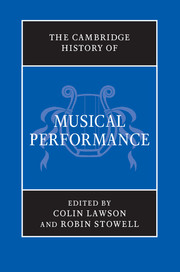Book contents
- Frontmatter
- PART I PERFORMANCE THROUGH HISTORY
- 1 Performance today
- 2 Political process, social structure and musical performance in Europe since 1450
- 3 The evidence
- 4 The performer and the composer
- 5 The teaching of performance
- 6 Music and musical performance: histories in disjunction?
- PART II PRE-RENAISSANCE PERFORMANCE
- PART III PERFORMANCE IN THE RENAISSANCE (C. 1430–1600)
- PART IV PERFORMANCE IN THE SEVENTEENTH CENTURY
- PART V PERFORMANCE IN THE ‘LONG EIGHTEENTH CENTURY’
- PART VI PERFORMANCE IN THE NINETEENTH CENTURY
- PART VII THE TWENTIETH CENTURY AND BEYOND
- PART VIII
- Index
2 - Political process, social structure and musical performance in Europe since 1450
from PART I - PERFORMANCE THROUGH HISTORY
Published online by Cambridge University Press: 28 March 2012
- Frontmatter
- PART I PERFORMANCE THROUGH HISTORY
- 1 Performance today
- 2 Political process, social structure and musical performance in Europe since 1450
- 3 The evidence
- 4 The performer and the composer
- 5 The teaching of performance
- 6 Music and musical performance: histories in disjunction?
- PART II PRE-RENAISSANCE PERFORMANCE
- PART III PERFORMANCE IN THE RENAISSANCE (C. 1430–1600)
- PART IV PERFORMANCE IN THE SEVENTEENTH CENTURY
- PART V PERFORMANCE IN THE ‘LONG EIGHTEENTH CENTURY’
- PART VI PERFORMANCE IN THE NINETEENTH CENTURY
- PART VII THE TWENTIETH CENTURY AND BEYOND
- PART VIII
- Index
Summary
I will examine the history of musical performance by, in political terms, seeing how a cultural community is shaped by differing groups and forces. Performing involves interaction among people involved in organising, paying, listening and interpreting. Their relationships may vary at any time from close collaboration to intense conflict. Different kinds of communities interact in this political process, variously the performing institution, a court or a city, and the state or a region of states. Negotiation must go on among participants, according to organisational rules, musical practices and financial constraints. Tradition and change compete with each other under pressure from social movements and individual opportunism. While these factors are usually just taken for granted, crises often make them articulated in print.
An efficient way to enquire into these social and political processes is to examine dualities which have recurred in Western musical life since the late Middle Ages. Involving collaboration and conflict to varying extents, the dualities within performing relationships can help us go beyond the banal phrase ‘Music and Society’ by identifying the dynamics aspects of musical culture. The first section of this chapter briefly examines musical dualities under three headings – Location, Production and Taste. The second section discusses how the dualities generally played out during four periods of music history since around 1450. Scholars typically agree that a public musical world emerged by around 1450 in Western and Central Europe, and we can see lines of continuity from that time to the present. It is indeed enlightening to see how the origins of modern practices can reach back so far.
- Type
- Chapter
- Information
- The Cambridge History of Musical Performance , pp. 35 - 62Publisher: Cambridge University PressPrint publication year: 2012
- 1
- Cited by



